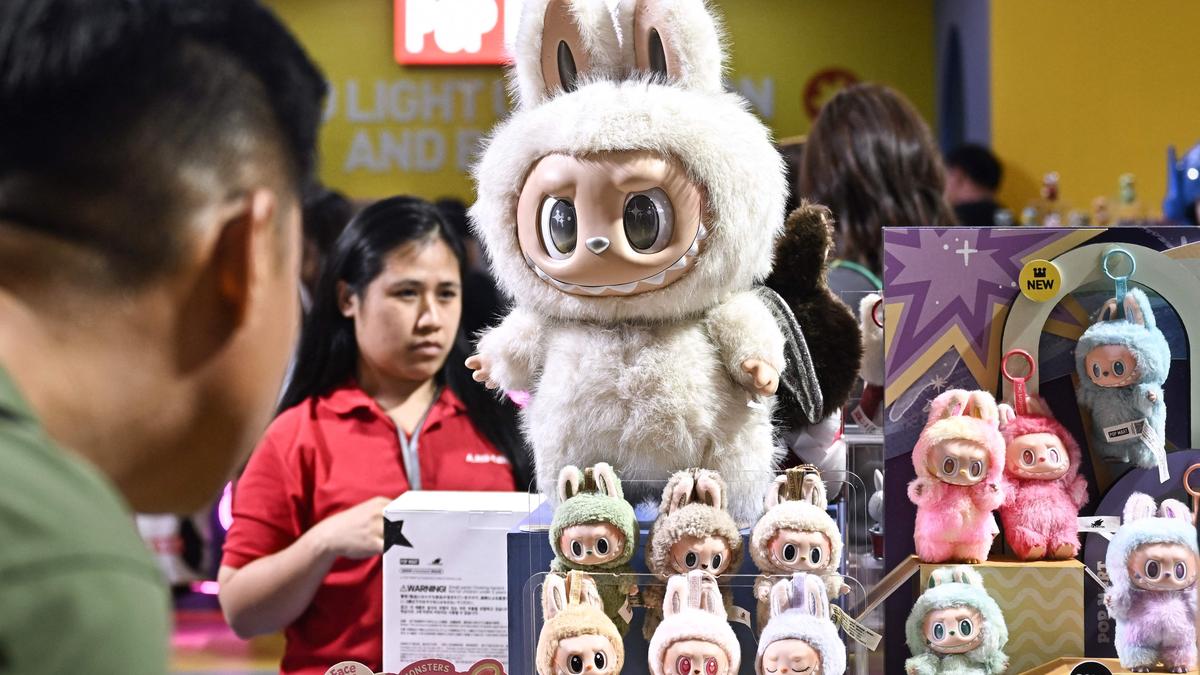When was the last time you walked into a brick-and-mortar store? Or needed to, with the Blinkits, Instamarts, and Amazons delivering everything to your doorstep? But despite the digital convenience, luxury retail is enticing people to step into physical spaces by evolving beyond transactions into sensory, immersive experiences — part atelier, part theatre, part shrine to tradition.
“It’s all about immersion. Today’s consumer wants spaces that reveal the ‘why’ behind what they’re taking home,” says Astha Khetan, co-founder of The House of Things. Once an esteemed online platform, the brand, as of March 2025, boasts a 25,000 sq.ft. concept store in Udaipur. Here, immersive vignettes and a thoughtfully curated spatial programme invite visitors to slow down and savour the store — from celebrating the richness of pichwai paintings to hands-on engagement with a tactile material library that includes everything from bone inlay to textural wallpapers.

Astha Khetan with The House of Things’ guest curator Feroze Gujral
Retail as a moodboard
The mission of highlighting quality craftsmanship and elevated design through experiential retail first bloomed in high-end, exclusive pockets: New Delhi’s Dhan Mill, once a warehouse hub dating back to 1978 and now a symbol of luxury boasting over 65 curated boutiques; Jaipur’s trendy C Scheme and Civil Lines; and South Mumbai’s Kala Ghoda, which saw entrants such as Tarun Tahliani’s Ensemble as early as the 1990s.
What once remained confined to these rarefied spaces is fast becoming a mainstream retail strategy, with brands across price points and across the country embracing strategic brand storytelling. Every larger-than-life flagship helmed by designer Sabyasachi Mukherjee in cities such as Mumbai, Kolkata, New Delhi, and Hyderabad is a maximalist performance — much like his clothes and jewellery. The store’s museum-like wallpapered and tapestry-lined walls are filled to the brim with pichwais, Tanjore paintings, vintage photography and lithographs, Mughal miniatures, and rare antiques. Not all of them are for sale. “It’s these enriching details that make me linger in the store, it makes me want to discover more,” says Reshma Bombaywala-Lezinska, a Mumbai-based jewellery designer and content creator.

Sabyasachi’s maximalist interiors
Sanjay Garg’s Raw Mango stores channel the brand’s ethos of constant evolution into pared-down design, redefining Indian minimalism. The spaces are generally left bare, raw, with no mannequins in sight, enabling key design elements to shine — such as Garg’s take on the Gandhian sofa, the Indian baithak, which has found its way into every outlet, or in Chennai, the building’s Art Deco heritage.

Raw Mango’s store in Chennai
The dialogue around Mumbai’s Nilaya Anthology by Asian Paints, one of India’s newest immersive design landmarks, has captured worldwide attention. The concept does away with barriers, both physically and metaphysically: spaces flow into one another, with a double-height orangery bringing the outdoors indoors; and the lines between gallery, museum, store and experience blur to carve out a sensorial sanctuary.

Nilaya Anthology | Photo Credit: Hashim Badani
“I grew up between Chennai and Bangalore, and I remember going to places like Sundari Silks, smelling the mallipoo, drinking coffee, and buying kanjeevaram saris,” says Pavitra Rajaram, design director of Asian Paints. “I feel like we’ve somehow lost the experience part of shopping now. So, I wanted Anthology to be a place of storytelling and experiences, where you come not to consume but to feel part of something, which then may drive your natural inclination to take home some part of that which resonates with you. But that’s not the primary intention.”
Fashion designer Ritu Beri’s Escape in Goa — with a 35-foot Portuguese-style façade in vibrant red and white, a bar, restaurant, and performance area, interspersed with Goan architectural elements such as cut laterite pathways and limestone mosaic floor tiles — is not just a store but a sanctuary of soul and story.

Escape’s Portuguese-style façade
She recalls a tiny Parisian boutique she once visited, with Edith Piaf humming in the background. Every lovingly curated item came with a handwritten tag narrating its story. “That blend of warmth, curation, and personal touch stayed with me,” she reminisces, and is something she brings to Escape.

Inside Escape
Craft meets commerce
The global rise of experiential retail heralds technological integration — from augmented reality (Farfetch’s London store linked online data to enhance the offline experience, letting users access their purchase history and favourites in real time), to the power of social media (as early as 2011, IKEA invited 100 Facebook competition winners for a personalised overnight stay at its warehouse), and most recently, AI integration, enabling personalised service, hands-free shopping via voice recognition, intelligent product search, and lead generation.
But, in India, it carries unique weight: retail is a site for both consumption and conservation.For example, renowned jewellery designer Sunita Shekhawat’s Museum of Meenakari Heritage (MoMH) in Jaipur orchestrates a fascinating dive into the history of enamelling from Renaissance Europe to its arrival in India. “At the Shekhawat Haveli, our retail space, we believe that even if someone leaves without a product, they should carry with them a deep appreciation for the centuries-old craft of meenakari and the cultural legacy it represents,” says Shekhawat.

Sunita Shekhawat | Photo Credit: Kewal Chholak
The by-appointment-only space features four private pods for client interactions, clad in off-white araish lime stucco and with semi-vaulted ceilings embellished with frescoes created by artists specialising in miniature painting. “We used the traditional technique, reinterpreted at a scale that is not normally used, to generate narratives around the flora and fauna of Rajasthan, grounding it to its context,” reveals Ambrish Arora, founding principal at Studio Lotus.

Frescoes in the private pods | Photo Credit: Ishita Sitwala
Arora and his team also developed the imposing, hand-carved red sandstone façade of MoMH, which draws from Jaipur’s Indo-Saracenic roots while offering an ode to Shekhawat’s Jodhpuri roots. “At the ground level, you enter a space that feels like a museum, [and is] open to the city,” he explains. “This transforms the space from one where products are sold to one that disseminates knowledge — a cultural destination. Storytelling has become essential in creating a unique and memorable retail identity.”

Museum of Meenakari Heritage’s hand-carved red sandstone façade | Photo Credit: Ishita Sitwala
Small but luxe
Today’s experiential luxury retail landscape has bifurcated into two distinct approaches: the grand spectacle of massive flagship stores and the concentrated elegance of smaller boutiques in premium enclaves like New Delhi’s Khan Market and Dhan Mill, where stores like Collectklove and AMPM prove that square footage does not dictate design impact. MuseLAB’s design for sanitaryware dealer Aquant’s new Mumbai showroom, for instance, is a veritable sorbet-toned wonderland with curved walls that remind you of gelato swirls.

Aquant | Photo Credit: Nayan Soni Photography
Or the futuristic, Brutalist and layered world of Unconventional, the multi-designer store in Kolkata — where a large, black, floor-to-ceiling sphere becomes the focal point of the design, revealing the store slowly as you walk around it.

Unconventional | Photo Credit: Niveditaa Gupta
Singular design elements can also be transformative, like the rich zardozi ceiling at fashion brand Divani’s New Delhi store, interwoven with semi-precious stones and nine tonnes of shimmering gold thread. Tarun Tahiliani’s Bengaluru store, which opened doors in December 2022, draws footfalls to date for a singular wall that reinvents the trompe-l’œil: a tree-of-life wallpaper brought to life through rich couture techniques such as intricate embroidery, painstakingly crafted by karigars from Lucknow and New Delhi — as an ode to his unwavering commitment to craftsmanship.
The new Indian retail is as much about how something is sold as what is sold. The store is not the backdrop, it’s the protagonist.
An architect-turned-journalist, the writer hopes her passion for storytelling drives an incisive cultural commentary.
Published - June 16, 2025 11:11 am IST

 8 hours ago
1
8 hours ago
1






















 English (US) ·
English (US) ·